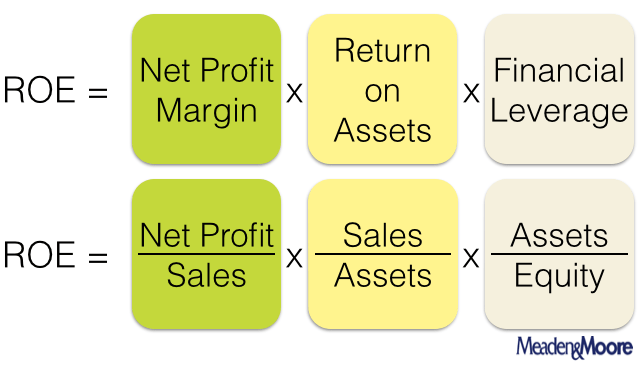How to Calculate Return on Equity (ROE) with the DuPont Formula
A DuPont analysis is an assessment of a company’s Return on Equity (ROE). Using the DuPont formula, an analyst  can easily determine a company’s financial strengths and weaknesses. According to the DuPont analysis, ROE is affected by three elements:
can easily determine a company’s financial strengths and weaknesses. According to the DuPont analysis, ROE is affected by three elements:
- Operating efficiency, which is measured by profit margin
- Asset management, which is measured by total asset turnover
- Financial leverage, which is measured by the equity multiplier
The DuPont Formula
ROE = Net Profit Margin (Profit/Sales) x Return on Assets (Sales/Assets) x Financial Leverage (Assets/Equity)
ROE is one of the most significant indicators of a firm's profitability and potential growth. Companies with substantial ROE's have greater ability to reinvest in their business and take cash withdrawals. One of the advantages of using the DuPont model to calculate ROE is that it incorporates aspects of both the income statement and balance sheet to analyze profitability.
Net Profit Margin = Profit/Sales
The first component of the DuPont formula is a company’s net profit margin, which is simply a firm's net profit divided by sales revenue. Of course, the greater the margin, the better as this is a clear
measure of a firm's operational effectiveness.
Return on Assets = Sales/Assets
The second component is Total Asset Turnover, which measures a company’s ability to convert assets into revenue. A higher asset turnover ratio signals a company’s efficient use of converting assets into revenue. However, firms with a higher asset turnover generally experience lower profit margins as the trade off to quicker sales is decreased pricing power. Similarly, firms with higher profit margins, such as those in retail industries, exhibit lower asset turnover ratios, due to competitive pricing strategies.
Financial Leverage = Assets/Equity
The final component of the DuPont formula is Financial Leverage as measured by Assets divided by shareholders’ Equity. By increasing financial leverage through increased debt (and tax deductible interest payments), a firm can increase its ROE. Increasing financial leverage through increased debt, however, affects a firm's riskiness; the greater the amount of debt a firm takes on, the greater the potential risk and reward. Thus, the tradeoff between risk and reward must be carefully analyzed.
In summary, to calculate your firm's ROE, multiply Net Profit Margin times Return on Assets (ROA) times Financial Leverage. ROE can then be used to compare companies within a given industry, and demonstrate to investors a firm's ability to effectively reinvest their capital. Dissecting ROE into these three components allows analysts to more easily understand the factors that influence changes in ROE over time. When used in tandem with liquidity, operating efficiency, and solvency ratios, the DuPont formula is an essential part of financial statement analysis.
Speak with a Meaden & Moore expert today to learn more.
You might also be interested in:
Managing Your Balance Sheet - Your Cash Cycle: Do you know what your cash cycle is? Find out how to calculate it in this blog post.
Alison Martanovic is a Senior Manager with Meaden & Moore and has been with the firm since graduating from John Carroll University in 2009. She coordinates and oversees daily fieldwork, prepares financial statements and executes various other aspects of the assurance engagement. Alison works with closely-held, entrepreneurial companies, serving a wide variety of industries including service, manufacturing, and construction both in the middle market and small business segments. She also works directly with numerous Not-for-Profit organizations performing attestation services and conducts audits of 401(k) plans, pension, and health and welfare plans.








